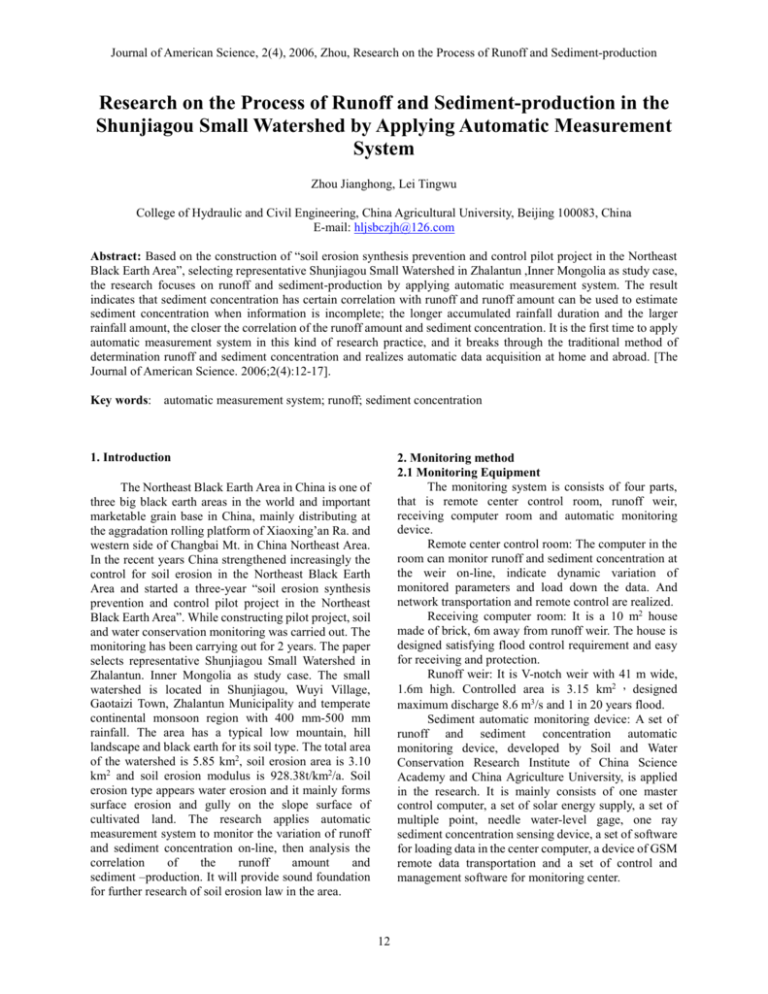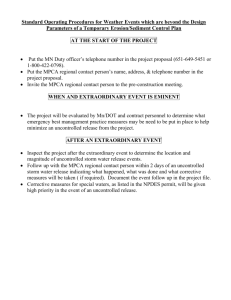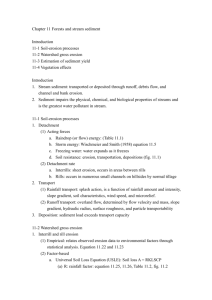Research on the Process of Runoff and Sediment
advertisement

Journal of American Science, 2(4), 2006, Zhou, Research on the Process of Runoff and Sediment-production Research on the Process of Runoff and Sediment-production in the Shunjiagou Small Watershed by Applying Automatic Measurement System Zhou Jianghong, Lei Tingwu College of Hydraulic and Civil Engineering, China Agricultural University, Beijing 100083, China E-mail: hljsbczjh@126.com Abstract: Based on the construction of “soil erosion synthesis prevention and control pilot project in the Northeast Black Earth Area”, selecting representative Shunjiagou Small Watershed in Zhalantun ,Inner Mongolia as study case, the research focuses on runoff and sediment-production by applying automatic measurement system. The result indicates that sediment concentration has certain correlation with runoff and runoff amount can be used to estimate sediment concentration when information is incomplete; the longer accumulated rainfall duration and the larger rainfall amount, the closer the correlation of the runoff amount and sediment concentration. It is the first time to apply automatic measurement system in this kind of research practice, and it breaks through the traditional method of determination runoff and sediment concentration and realizes automatic data acquisition at home and abroad. [The Journal of American Science. 2006;2(4):12-17]. Key words: automatic measurement system; runoff; sediment concentration 1. Introduction 2. Monitoring method 2.1 Monitoring Equipment The monitoring system is consists of four parts, that is remote center control room, runoff weir, receiving computer room and automatic monitoring device. Remote center control room: The computer in the room can monitor runoff and sediment concentration at the weir on-line, indicate dynamic variation of monitored parameters and load down the data. And network transportation and remote control are realized. Receiving computer room: It is a 10 m2 house made of brick, 6m away from runoff weir. The house is designed satisfying flood control requirement and easy for receiving and protection. Runoff weir: It is V-notch weir with 41 m wide, 1.6m high. Controlled area is 3.15 km2 , designed maximum discharge 8.6 m3/s and 1 in 20 years flood. Sediment automatic monitoring device: A set of runoff and sediment concentration automatic monitoring device, developed by Soil and Water Conservation Research Institute of China Science Academy and China Agriculture University, is applied in the research. It is mainly consists of one master control computer, a set of solar energy supply, a set of multiple point, needle water-level gage, one ray sediment concentration sensing device, a set of software for loading data in the center computer, a device of GSM remote data transportation and a set of control and management software for monitoring center. The Northeast Black Earth Area in China is one of three big black earth areas in the world and important marketable grain base in China, mainly distributing at the aggradation rolling platform of Xiaoxing’an Ra. and western side of Changbai Mt. in China Northeast Area. In the recent years China strengthened increasingly the control for soil erosion in the Northeast Black Earth Area and started a three-year “soil erosion synthesis prevention and control pilot project in the Northeast Black Earth Area”. While constructing pilot project, soil and water conservation monitoring was carried out. The monitoring has been carrying out for 2 years. The paper selects representative Shunjiagou Small Watershed in Zhalantun. Inner Mongolia as study case. The small watershed is located in Shunjiagou, Wuyi Village, Gaotaizi Town, Zhalantun Municipality and temperate continental monsoon region with 400 mm-500 mm rainfall. The area has a typical low mountain, hill landscape and black earth for its soil type. The total area of the watershed is 5.85 km2, soil erosion area is 3.10 km2 and soil erosion modulus is 928.38t/km2/a. Soil erosion type appears water erosion and it mainly forms surface erosion and gully on the slope surface of cultivated land. The research applies automatic measurement system to monitor the variation of runoff and sediment concentration on-line, then analysis the correlation of the runoff amount and sediment –production. It will provide sound foundation for further research of soil erosion law in the area. 12 Journal of American Science, 2(4), 2006, Zhou, Research on the Process of Runoff and Sediment-production Monitoring Station, Inner Mongolia as study case, analysis the correlation runoff and sediment concentration in the watershed in order to provide a research base for further study. 2.2 Monitoring Procedure 1) When rainfall forms runoff, flows through the weir and water level reaches certain height, the system will start automatically. 2) A sediment concentration device is put into the depth where survey is designed to carry out at the weir; four ray sediment concentration sensing devices are put in the runoff cross vertically to monitor gradient variation of sediment concentration at the runoff cross. Runoff and sediment concentration can be calculated by using the monitored data from sediment concentration device and weir. When sensing device starts working, system will survey, collect and memory the sensing data. 3) The master control computer controls and manages each sensing device and gets monitored sediment concentration and runoff through working management and data memory software. A set of data, that is sediment concentration, water level and corresponding time, is memorized in the master control computer. 4) The data are loaddowned through RS232 interface timely, otherwise the data may be overlapped by new data or loss due to system failure. The data can also be transported to monitoring center by means of GSM remote data transportation net, conducting real-time operation, load downing data, looking up data, analyzing data and printing data. Automatic monitoring is realized. 3.1 Correlation of Runoff and Sediment Concentration Sediment concentration G is an important parameter to indicate sediment production in a watershed. Under certain condition, the greater sediment discharge, the higher sediment production. In the paper G can be expressed as G=q×c in which q=runoff (m3/s); c=sediment discharge (kg/m3)。 Figure 1, Figure 2 and Figure 3 are linear relation figures of runoff and sediment concentration on 19,20 and 21 June at Zhalantun Monitoring Station. The figures show that runoff and sediment concentration have good relativity and Table 1 indicates that the correlation coefficient at each monitoring station reaches 0.83. All facts demonstrate that there is a corresponding relation between Runoff amount and sediment concentration, sediment concentration increases with the runoff increase, namely water flow capacity for carrying soil increases with the runoff increase. The relation differs at different time. Maybe the difference is caused by rainfall intensity, rainfall duration and other factors. 3. Findings and Analysis The paper takes hydrologic data at Zhalantun Sediment 3 Concentration(kg/m ) (1) 0.25 0.2 0.15 y = 24.834x - 0.0544 R2 = 0.7013 0.1 0.05 0 0.000 -0.05 0.005 0.010 3 Runoff Amount(m /s) Figure 1. Runoff Amount and Sediment Concentration Relations at Zhalantun Hydrologic Station July 19 13 Journal of American Science, 2(4), 2006, Zhou, Research on the Process of Runoff and Sediment-production Sediment 3 Concentration(kg/m ) 0.07 y = 8.8064x - 0.0135 R2 = 0.8762 0.06 0.05 0.04 0.03 0.02 0.01 0 0.000 0.002 0.004 0.006 0.008 0.010 3 Runoff Amount(m /s) Sediment Concentration(kg/s) Figure 2. Runoff Amount and Sediment Concentration Relations at Zhalantun Hydrologic Station on July 20 2 1.5 1 y = 25.269x - 0.2088 R2 = 0.9727 0.5 0 0.00 -0.5 0.02 0.04 0.06 0.08 0.10 Runoff Amount(m3/s) Figure 3. Runoff Amount and Sediment Concentration Relations at Zhalantun Hydrologic Station on July 21 Table 1. Runoff amount and sediment concentration fitting equation and correlation coefficient Station Zhalantun June 19 Zhalantun June 20 Zhalantun June 21 R2 0.7013 0.8762 0.9727 fitting equation Y=24.834-0.0544 Y=24.834-0.0544 Y=24.834-0.0544 correlation coefficient R 0.8374 0.9361 0.9863 3.2 Relation of Sediment Concentration and Runoff Figure 4, Figure 5 and Figure 6 show the variation of sediment concentration and runoff. The figures indicate that the variation of sediment concentration is basically same as the variation of runoff. From the figures we can find that the variation of sediment concentration and runoff is divided into two periods, namely rising segment and falling segment. With the increase of rainfall duration, runoff and sediment all climb up and reach their peak, then turn to their falling segment. 14 0.01 0.01 0.01 0.01 0.01 0.01 0.00 0.00 0.00 0.00 0.00 20:24:00 25.0 Sediment 3 Concentration(kg/m ) 3 Runoff Amount(m /s) Journal of American Science, 2(4), 2006, Zhou, Research on the Process of Runoff and Sediment-production 20.0 15.0 10.0 5.0 21:36:00 22:48:00 0.0 0:00:00 0.009 0.008 0.007 0.006 0.005 0.004 0.003 0.002 0.001 0.000 18:00:00 12.0 10.0 8.0 6.0 4.0 2.0 19:12:00 20:24:00 21:36:00 Sediment Concentration(kg/m3) Runoff Amount(m3/s) Figure 4. Runoff Amount and Sediment Concentration Change Curve at Zhalantun Hydrologic Station on July 19 0.0 22:48:00 0.09 0.08 0.07 25.0 20.0 0.06 0.05 0.04 0.03 0.02 0.01 0.00 15.0 10.0 5.0 0.0 0:00: 1:12: 2:24: 3:36: 4:48: 6:00: 7:12: 8:24: 00 00 00 00 00 00 00 00 Sediment Concentration(kg/m3) Runoff Amount(m3/s) Figure 5. Runoff Amount and Sediment Concentration Change Curve at Zhalantun Hydrologic Station on July 20 Figure 6. Runoff Amount and Sediment Concentration Change Curve at Zhalantun Hydrologic Station on July 21 15 Journal of American Science, 2(4), 2006, Zhou, Research on the Process of Runoff and Sediment-production concentration monitoring should be strengthened in future monitoring in order to set up relation of rainfall, discharge and sediment discharge. 3.3 Calculation of Cumulative Rainfall and Cumulative Sediment Discharge When hydrologic data are complete we can calculate cumulative runoff and cumulative sediment discharge for one time rainfall. It compares with cumulative rainfall and gets their relation. Cumulative runoff can be expressed as t n 0 i 0 Q qdt q t Correspondence to: Lei Tingwu China Agricultural University 151# E-mail: ddragon@public3.bta.net.cn (2) i in which Q=cumulative runoff of certain period (m3) ; t=time runoff flowing whole watershed(s) ;△t=interval Zhou Jianghong No.4 Wenzhong Street Nan gang District Harbin, Heilongjiang 150001, China E-mail: hljsbczjh@126.com of survey(s) ;q i =runoff at certain survey time(m3/s) ; i 0,1,2 n Survey number of calculated period. Based on formula(1), Cumulative sediment discharge is expressed correspondingly as t n 0 i 0 G qcdt c q t g t t in which Author : Zhou Jianghong, Female, born in 1968, Ph.D.,mainly Engaged in the reseach of soil erosion process and mechanism, E-mail: hljsbczjh@126.com n i i i 0 i (3) Received: 8/28/2006 Gt =cumulative sediment discharge of certain period(kg) ; g i =sediment discharge of certain survey References 1. Lei Tingwu, Wang Hui, Zhao Jun, Liu Qingkun, Xia Weiheng. Automatic system for dynamical determination of sediment concentration and flow rate in runoff. [J]. Transactions of the CSAE, 2002, 18(5): 48-51. 2. Zhen Fenli. Discusion on the Research Fields in Soil Erosion Study Which Should be Stretched Urgently in China. Research of Soil and Water Conservation,1999,6(2) :26-31 3. Fan Yanzhun, Zhang Hongmei, Cheng Ying. New Development on Sediment Concentration Measurement. Bulletin of Wuhan Hyraulic and hydropower University,1999,32(3) :55-57 4. Liu Junhua , Intelligect Sensing System. : Publishing House of Xi’an Electronic Science and Technology University,1999.197-209 5. Fu Suhua, Fu Jinsheng, Wan Xiaolan. Measuring Method Study on the Sediment Concentration of Collector in runoff Small Area. Bulletin of Soil and Water Conservation,2003,6:40-42 6. Ye Zhihan,Liu Baoyuan,Lu Bingjun. Study and Experiment on Sampler of Sediment Concentration Collector in Small Runoff Area. Sediment Research,2005,3:26-31 7. Mu Xingmin, Wang Fei, Li Jing. New Development of Assessment Method on the Impact of Soil and Water Conservation Measures on River Runoff. Bulletin of Soil and Water Conservation,2004,3:77-82 8. Gao Peiling, Lei Tingwu , Zhao Jun. Method period(kg/s ) ; c i =sediment concentration of certain survey period(kg/m3)。 4. Conclusions 1) It is the first time to apply automatic measurement system in this kind of research practice, and it breaks through the traditional method of determination runoff and sediment concentration and realizes automatic data acquisition by computer, on-line, real-time and automatic measurement .The method reaches good results. 2) There is certain relativity of sediment discharge and runoff. It indicates that runoff can be used to estimate sediment discharge when the data are not complete, and the longer the cumulative rainfall duration and the greater cumulative runoff, the closer the relation of sediment discharge and runoff. From the variation of runoff and sediment concentration, their variations are basically same. They increase with rainfall duration and when reach their peaks, begin to decrease. The variation presents directly two periods, namely rising and falling segment. 3) Calculation methods for cumulative runoff and cumulative sediment discharge are put forward. Their relativity with cumulative rainfall and sediment-production laws for different regions and different rainfall will be considered in further research. Quotient of cumulative sediment discharge and cumulative runoff can be calculated to demonstrate the character of underlying surface. 4) Rainfall data collation corresponding the sediment 16 Journal of American Science, 2(4), 2006, Zhou, Research on the Process of Runoff and Sediment-production 9. Research and Forecasting on Runoff Sediment Concentration of Slope Erosion. Sediment Research,2004,5:30-35 Fan Yanzhun, Zhang Hongmei, Cheng Ying. New Development on Sediment Concentration Measurement. Bulletin of Wuhan Hyraulic and hydropower University,1999,3:56-58 10. Gao Peiling, Lei Tingwu, Shao Ming’an. Experiment and Research on Automatic Measurement System of Runoff and Soil Erosion in Small Watershed. Journal of Agricultural Engineering,2005,10:174-176. 17








